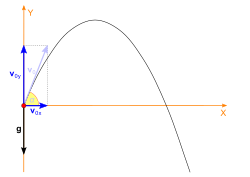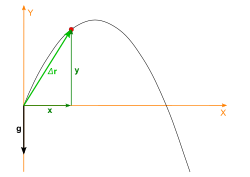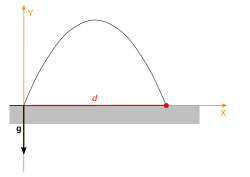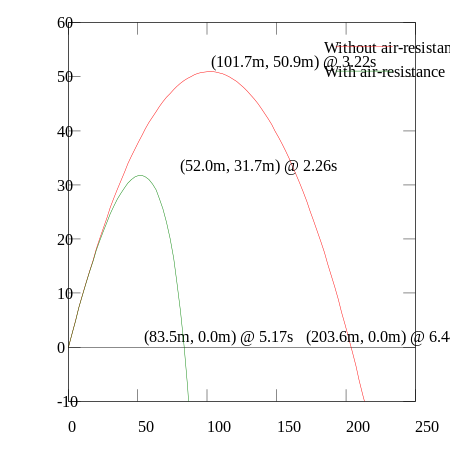PHYSICS PROJECT REPORT ON PROJECTILE MOTION
Projectile motion is a form of motion experienced by an object or particle (a projectile) that is thrown near the Earth’s surface and moves along a curved path under the action of gravity only (in particular, the effects of air resistance are assumed to be negligible). This curved path was shown by Galileo to be a parabola. The study of such motions is called ballistics, and such a trajectory is a ballistic trajectory. The only force of significance that acts on the object is gravity, which acts downward, thus imparting to the object a downward acceleration. Because of the object’s inertia, no external horizontal force is needed to maintain the horizontal velocity component of the object. Taking other forces into account, such as friction from aerodynamic drag or internal propulsion such as in a rocket, requires additional analysis. A ballistic missile is a missile only guided during the relatively brief initial powered phase of flight, and whose subsequent course is governed by the laws of classical mechanics.
Ballistics (gr. βάλλειν (‘ba’llein’), “to throw”) is the science of mechanics that deals with the flight, behavior, and effects of projectiles, especially bullets, unguided bombs, rockets, or the like; the science or art of designing and accelerating projectiles so as to achieve a desired performance.
The elementary equations of ballistics neglect nearly every factor except for initial velocity and an assumed constant gravitational acceleration. Practical solutions of a ballistics problem often require considerations of air resistance, cross winds, target motion, varying acceleration due to gravity, and in such problems as launching a rocket from one point on the Earth to another, the rotation of the Earth. Detailed mathematical solutions of practical problems typically do not have closed-form solutions, and therefore require numerical methods to address.
Contents
- 1The initial velocity
- 2Kinematic quantities of projectile motion
- 3Time of flight or total time of the whole journey
- 4Maximum height of projectile
- 5Relation between horizontal range and maximum height
- 6Maximum distance of projectile
- 7Application of the work energy theorem
- 8Angle of reach
- 9Angle {\displaystyle \theta } required to hit coordinate (x,y)
- 10Catching balls
- 11Trajectory of a projectile with air resistance
- 12Lofted trajectory
- 13References
The initial velocity
Let the projectile be launched with an initial velocity {\displaystyle \mathbf {v} (0)\equiv \mathbf {v} _{0}}, which can be expressed as the sum of horizontal and vertical components as follows:
- {\displaystyle \mathbf {v} _{0}=v_{0x}\mathbf {i} +v_{0y}\mathbf {j} }.
The components {\displaystyle v_{0x}} and {\displaystyle v_{0y}} can be found if the initial launch angle, {\displaystyle \theta }, is known:
- {\displaystyle v_{0x}=v_{0}\cos \theta },
- {\displaystyle v_{0y}=v_{0}\sin \theta }.
Kinematic quantities of projectile motion
In projectile motion, the horizontal motion and the vertical motion are independent of each other; that is, neither motion affects the other. This is the principle of compound motionestablished by Galileo in 1638.
Acceleration
Since there is only acceleration in the vertical direction, the velocity in the horizontal direction is constant, being equal to {\displaystyle \mathbf {v} _{0}\cos \theta }. The vertical motion of the projectile is the motion of a particle during its free fall. Here the acceleration is constant, being equal to g.The components of the acceleration are-
- {\displaystyle a_{x}=0},
- {\displaystyle a_{y}=-g}.
Velocity
The horizontal component of the velocity of the object remains unchanged throughout the motion. The vertical component of the changes linearly,because the acceleration due to gravity is constant. The accelerations in the x and y directions can be integrated to solve for the components of velocity at any time t, as follows:
- {\displaystyle v_{x}=v_{0}\cos(\theta )},
- {\displaystyle v_{y}=v_{0}\sin(\theta )-gt}.
The magnitude of the velocity (under the Pythagorean theorem, also known as the triangle law):
- {\displaystyle v={\sqrt {v_{x}^{2}+v_{y}^{2}\ }}}.
Displacement
At any time {\displaystyle t}, the projectile’s horizontal and vertical displacement are:
- {\displaystyle x=v_{0}t\cos(\theta )},
- {\displaystyle y=v_{0}t\sin(\theta )-{\frac {1}{2}}gt^{2}}.
The magnitude of the displacement is:
- {\displaystyle \Delta r={\sqrt {x^{2}+y^{2}\ }}}.
Consider the equations,
- {\displaystyle x=v_{0}t\cos(\theta ),y=v_{0}t\sin(\theta )-{\frac {1}{2}}gt^{2}}.
If t is eliminated between these two equations the following equation is obtained:
- {\displaystyle y=\tan(\theta )\cdot x-{\frac {g}{2v_{0}^{2}\cos ^{2}\theta }}\cdot x^{2}}.
Since g, θ, and v0 are constants, the above equation is of the form
- {\displaystyle y=ax+bx^{2}},
in which a and b are constants. This is the equation of a parabola, so the path is parabolic. The axis of the parabola is vertical.
If the projectile’s position (x,y) and launch angle (θ or α) are known, the initial velocity can be found solving for v0 in the aforementioned parabolic equation:
- {\displaystyle v_{0}={\sqrt {{x^{2}g} \over {x\sin 2\theta -2y\cos ^{2}\theta }}}}.
Time of flight or total time of the whole journey
The total time t for which the projectile remains in the air is called the time of flight.
- {\displaystyle y=v_{0}t\sin(\theta )-{\frac {1}{2}}gt^{2}}
After the flight, the projectile returns to the horizontal axis (x-axis), so {\displaystyle y=0}.
- {\displaystyle 0=v_{0}t\sin(\theta )-{\frac {1}{2}}gt^{2}}
- {\displaystyle v_{0}t\sin(\theta )={\frac {1}{2}}gt^{2}}
- {\displaystyle v_{0}\sin(\theta )={\frac {1}{2}}gt}
- {\displaystyle t={\frac {2v_{0}\sin(\theta )}{g}}}
Note that we have neglected air resistance on the projectile.
If the starting point is at height y0 with respect to the point of impact, the time of flight is:
- {\displaystyle t={\frac {d}{v\cos \theta }}={\frac {v\sin \theta +{\sqrt {(v\sin \theta )^{2}+2gy_{0}}}}{g}}}
As above, this expression can be reduced to
- {\displaystyle t={\frac {v\sin {\theta }+{\sqrt {(v\sin {\theta })^{2}}}}{g}}={\frac {v\sin {\theta }+v\sin {\theta }}{g}}={\frac {2v\sin {\theta }}{g}}={\frac {2v\sin {(45)}}{g}}={\frac {2v{\frac {\sqrt {2}}{2}}}{g}}={\frac {{\sqrt {2}}v}{g}}}
if θ is 45° and y0 is 0.
Maximum height of projectile[edit]
The greatest height that the object will reach is known as the peak of the object’s motion. The increase in height will last until {\displaystyle v_{y}=0}, that is,
- {\displaystyle 0=v_{0}\sin(\theta )-gt_{h}}.
Time to reach the maximum height(h):
- {\displaystyle t_{h}={\frac {v_{0}\sin(\theta )}{g}}}.
From the vertical displacement of the maximum height of projectile:
- {\displaystyle h=v_{0}t_{h}\sin(\theta )-{\frac {1}{2}}gt_{h}^{2}}
- {\displaystyle h={\frac {v_{0}^{2}\sin ^{2}(\theta )}{2g}}} .
Relation between horizontal range and maximum height
The relation between the range R on the horizontal plane and the maximum height h reached at {\displaystyle {\frac {t_{d}}{2}}} is:
- {\displaystyle h={\frac {R\tan \theta }{4}}}
Proof
{\displaystyle h={\frac {v_{0}^{2}\sin ^{2}\theta }{2g}}}
- {\displaystyle R={\frac {v_{0}^{2}\sin 2\theta }{g}}}
- {\displaystyle {\frac {h}{R}}={\frac {v_{0}^{2}\sin ^{2}\theta }{2g}}} × {\displaystyle {\frac {g}{v_{0}^{2}\sin 2\theta }}}
- {\displaystyle {\frac {h}{R}}={\frac {\sin ^{2}\theta }{4\sin \theta \cos \theta }}}
{\displaystyle h={\frac {R\tan \theta }{4}}}.
Maximum distance of projectile
The range and the maximum height of the projectile does not depend upon its mass. Hence range and maximum height are equal for all bodies that are thrown with the same velocity and direction. The horizontal range d of the projectile is the horizontal distance it has traveled when it returns to its initial height ({\displaystyle y=0}).
- {\displaystyle 0=v_{0}t_{d}\sin(\theta )-{\frac {1}{2}}gt_{d}^{2}}.
Time to reach ground:
- {\displaystyle t_{d}={\frac {2v_{0}\sin(\theta )}{g}}}.
From the horizontal displacement the maximum distance of projectile:
- {\displaystyle d=v_{0}t_{d}\cos(\theta )},
so
- {\displaystyle d={\frac {v_{0}^{2}}{g}}\sin(2\theta )}.
Note that d has its maximum value when
- {\displaystyle \sin 2\theta =1},
which necessarily corresponds to
- {\displaystyle 2\theta =90^{\circ }},
or
- {\displaystyle \theta =45^{\circ }}.
Trajectories of projectiles launched at different elevation angles but the same speed of 10 m/s in a vacuum and uniform downward gravity field of 10 m/s2. Points are at 0.05 s intervals and length of their tails is linearly proportional to their speed. t= time from launch, T = time of flight, R = range and H = highest point of trajectory (indicated with arrows).
The total horizontal distance (d) traveled.
- {\displaystyle d={\frac {v\cos \theta }{g}}\left(v\sin \theta +{\sqrt {(v\sin \theta )^{2}+2gy_{0}}}\right)}
When the surface is flat (initial height of the object is zero), the distance traveled:
- {\displaystyle d={\frac {v^{2}\sin(2\theta )}{g}}}
Thus the maximum distance is obtained if θ is 45 degrees. This distance is:
- {\displaystyle d={\frac {v^{2}}{g}}}
Application of the work energy theorem
According to the work-energy theorem the vertical component of velocity is:
- {\displaystyle v_{y}^{2}=(v_{0}\sin \theta )^{2}-2gy}.
These formulae ignore aerodynamic drag and also assume that the landing area is at uniform height 0.
Angle of reach
The “angle of reach” is the angle (θ) at which a projectile must be launched in order to go a distance d, given the initial velocity v.
- {\displaystyle \sin(2\theta )={\frac {gd}{v^{2}}}}
There are two solutions:
- {\displaystyle \theta ={\frac {1}{2}}\arcsin \left({\frac {gd}{v^{2}}}\right)}
and
- {\displaystyle \theta =90^{\circ }-{\frac {1}{2}}\arcsin \left({\frac {gd}{v^{2}}}\right)}
Angle {\displaystyle \theta } required to hit coordinate (x,y)
|
This section does not cite any sources. (October 2017) (Learn how and when to remove this template message)
|
To hit a target at range x and altitude y when fired from (0,0) and with initial speed v the required angle(s) of launch θ are:
- {\displaystyle \theta =\arctan {\left({\frac {v^{2}\pm {\sqrt {v^{4}-g(gx^{2}+2yv^{2})}}}{gx}}\right)}}
The two roots of the equation correspond to the two possible launch angles, so long as they aren’t imaginary, in which case the initial speed is not great enough to reach the point (x,y) selected. This formula allows one to find the angle of launch needed without the restriction of {\displaystyle y=0}.
One can also ask what launch angle allows the lowest possible launch velocity. This occurs when the two solutions above are equal, implying that the quantity under the square root sign is zero. This requires solving a quadratic equation for {\displaystyle v^{2}}, and we find
- {\displaystyle v^{2}/g=y+{\sqrt {y^{2}+x^{2}}}.}
This gives
- {\displaystyle \theta =\arctan \left(y/x+{\sqrt {y^{2}/x^{2}+1}}\right).}
If we denote than angle whose tangent is y/x by α, then
- {\displaystyle \tan \theta ={\frac {\sin \alpha +1}{\cos \alpha }}}
- {\displaystyle \tan(\pi /2-\theta )={\frac {\cos \alpha }{\sin \alpha +1}}}
- {\displaystyle \cos ^{2}(\pi /2-\theta )={\frac {1}{2}}(\sin \alpha +1)}
- {\displaystyle 2\cos ^{2}(\pi /2-\theta )-1=\cos(\pi /2-\alpha )}
This implies
- {\displaystyle \pi /2-\theta ={\frac {1}{2}}(\pi /2-\alpha ).}
In other words, the launch should be at the angle halfway between the target and the zenith.
Catching balls
|
This section does not cite any sources. (October 2017) (Learn how and when to remove this template message)
|
If a projectile, such as a baseball or cricket ball, travels in a parabolic path, with negligible air resistance, and if a player is positioned so as to catch it as it descends, he sees its angle of elevation increasing continuously throughout its flight. The tangent of the angle of elevation is proportional to the time since the ball was sent into the air, usually by being struck with a bat. Even when the ball is really descending, near the end of its flight, its angle of elevation seen by the player continues to increase. The player therefore sees it in line with a point ascending vertically from the batsman at constant speed. Finding the place from which the ball appears to rise steadily helps the player to position himself correctly to make the catch. If he is too close to the batsman who has hit the ball, it will appear to rise at an accelerating rate. If he is too far from the batsman, it will appear to slow rapidly, and then to descend.
Proof
Suppose the ball starts with a vertical component of velocity of vy upward, and a horizontal component of velocity of vx toward the player who wants to catch it. Its altitude above the ground is given by:
- {\displaystyle h=v_{y}t-{\frac {1}{2}}gt^{2},} where t is the time since the ball was hit.
The total time for the flight, until the ball is back down to the ground, {\displaystyle h=0}, is given by:
- {\displaystyle \therefore T={\frac {2v_{y}}{g}}.}
The horizontal component of the distance the ball travels from its starting point to time t {\displaystyle (0\leq t\leq T)} is
- {\displaystyle d=v_{x}t}
The total horizontal distance the ball travels from its starting point to the point where it is caught is:
- {\displaystyle D=d(T)={\frac {2v_{x}v_{y}}{g}}}
The horizontal component of the ball’s distance from the catcher at time t is:
- {\displaystyle c=D-d={\frac {2v_{x}v_{y}}{g}}-v_{x}t}
The tangent of the angle of elevation of the ball, as seen by the catcher, is:
- {\displaystyle \tan(e)={\frac {h}{c}}}
- {\displaystyle ={\frac {v_{y}t-{\frac {1}{2}}gt^{2},}{{\frac {2v_{x}v_{y}}{g}}-v_{x}t}}}
- {\displaystyle ={\frac {gt}{2v_{x}}}}
While the ball is in flight:
- {\displaystyle \tan(e)=\left({\frac {g}{2v_{x}}}\right)t}
The bracket in this last expression is constant for a given flight. Therefore, the tangent of the angle of elevation of the ball, as seen by the player who is properly positioned to catch it, is directly proportional to the time since the ball was hit.
Trajectory of a projectile with air resistance
|
|
This article needs attention from an expert in Physics. (June 2008)
|
Trajectories of a mass thrown at an angle of 70°:
without drag
with Stokes drag
with Newton drag
In this section we will take air resistance to be in direct proportion to the velocity of the particle (i.e. {\displaystyle F_{a}\propto {\vec {v}}}). This is only valid at Reynolds number below about 1000. In air, which has a kinematic viscosity around 0.15 cm2/s this means that the product of speed and diameter must be less than about 150 cm2/s which is obviously not usually the case. We do this though so that the equations describing the particle’s motion are easily solved. At higher values of speed times diameter (high Reynolds number) the force of air resistance is proportional to the square of the particle’s velocity (see drag equation). Here, {\displaystyle v_{0}},{\displaystyle v_{x}} and {\displaystyle v_{y}} will be used to denote the initial velocity, the velocity along the direction of x and the velocity along the direction of y, respectively. The mass of the projectile will be denoted by m. For the derivation only the case where {\displaystyle 0^{o}\leq \theta \leq 180^{o}} is considered. Again, the projectile is fired from the origin (0,0).
The free body diagram on the right is for a projectile that experiences air resistance and the effects of gravity. Here, air resistance is assumed to be in the direction opposite of the projectile’s velocity. {\displaystyle F_{air}=-kv} (actually {\displaystyle F_{air}=-kv^{2}} is more realistic, but not used here, to ensure an analytic solution,) is written due to the initial assumption of direct proportionality implies that the air resistance and the velocity differ only by a constant arbitrary factor with units of N*s/m.
The relationships that represent the motion of the particle are derived by Newton’s Second Law, both in the x and y directions. In the x direction {\displaystyle \Sigma F=-kv_{x}=ma_{x}} and in the y direction {\displaystyle \Sigma F=-kv_{y}-mg=ma_{y}}.
This implies that:
{\displaystyle a_{x}={\frac {-kv_{x}}{m}}={\frac {dv_{x}}{dt}}} (1),
and
{\displaystyle a_{y}={\frac {1}{m}}(-kv_{y}-mg)={\frac {-kv_{y}}{m}}-g={\frac {dv_{y}}{dt}}} (2)
Solving (1) is an elementary differential equation, thus the steps leading to a unique solution for vx and, subsequently, x will not be enumerated. Given the initial conditions {\displaystyle v_{x}=v_{xo}} (where vxo is understood to be the x component of the initial velocity) and {\displaystyle s_{x}=0} for {\displaystyle t=0}:
{\displaystyle v_{x}=v_{xo}e^{-{\frac {k}{m}}t}} (1a)
{\displaystyle s_{x}={\frac {m}{k}}v_{xo}(1-e^{-{\frac {k}{m}}t})} (1b)
While (1) is solved much in the same way, (2) is of distinct interest because of its non-homogeneous nature. Hence, we will be extensively solving (2). Note that in this case the initial conditions are used {\displaystyle v_{y}=v_{yo}} and {\displaystyle s_{y}=0} when {\displaystyle t=0}.
{\displaystyle {\frac {dv_{y}}{dt}}={\frac {-k}{m}}v_{y}-g} (2)
{\displaystyle {\frac {dv_{y}}{dt}}+{\frac {k}{m}}v_{y}=-g} (2a)
This first order, linear, non-homogeneous differential equation may be solved a number of ways; however, in this instance, it will be quicker to approach the solution via an integrating factor {\displaystyle e^{\int {\frac {k}{m}}\,dt}}.
{\displaystyle e^{{\frac {k}{m}}t}({\frac {dv_{y}}{dt}}+{\frac {k}{m}}v_{y})=e^{{\frac {k}{m}}t}(-g)} (2c)
{\displaystyle (e^{{\frac {k}{m}}t}v_{y})^{\prime }=e^{{\frac {k}{m}}t}(-g)} (2d)
{\displaystyle \int {(e^{{\frac {k}{m}}t}v_{y})^{\prime }\,dt}=e^{{\frac {k}{m}}t}v_{y}=\int {e^{{\frac {k}{m}}t}(-g)\,dt}} (2e)
{\displaystyle e^{{\frac {k}{m}}t}v_{y}={\frac {m}{k}}e^{{\frac {k}{m}}t}(-g)+C}(2f)
{\displaystyle v_{y}={\frac {-mg}{k}}+Ce^{{\frac {-k}{m}}t}} (2g)
And by integration we find:
{\displaystyle s_{y}=-{\frac {mg}{k}}t-{\frac {m}{k}}(v_{yo}+{\frac {mg}{k}})e^{-{\frac {k}{m}}t}+C} (3)
Solving for our initial conditions:
{\displaystyle v_{y}(t)=-{\frac {mg}{k}}+(v_{yo}+{\frac {mg}{k}})e^{-{\frac {k}{m}}t}} (2h)
{\displaystyle s_{y}(t)=-{\frac {mg}{k}}t-{\frac {m}{k}}(v_{yo}+{\frac {mg}{k}})e^{-{\frac {k}{m}}t}+{\frac {m}{k}}(v_{yo}+{\frac {mg}{k}})} (3a)
With a bit of algebra to simplify (3a):
{\displaystyle s_{y}(t)=-{\frac {mg}{k}}t+{\frac {m}{k}}(v_{yo}+{\frac {mg}{k}})(1-e^{-{\frac {k}{m}}t})} (3b)
An example is given using values for the mass and terminal velocity for a baseball taken from
- m = 0.145 kg (5.1 oz)
- v0 = 44.7 m/s (100 mph)
- g = -9.81 m/s² (-32.2 ft/s²)
- vt = -33.0 m/s (-73.8 mph)
- {\displaystyle k={\frac {mg}{v_{t}}}={\frac {(0.145{\mbox{ kg}})(-9.81\ \mathrm {m} /\mathrm {s} ^{2})}{-33.0\ \mathrm {m} /\mathrm {s} }}=0.0431{\mbox{ kg}}/{\mbox{s}},\ \theta =45^{o}}.
The more realistic trajectory {\displaystyle F_{air}=-k\left\vert v\right\vert v} can not be calculated analytically, but only by numerical simulations.
Similarly to above:
{\displaystyle a_{x}={\frac {-k{v_{x}}^{2}}{m}}={\frac {dv_{x}}{dt}}}
{\displaystyle v_{x}={\begin{cases}{\frac {1}{{\frac {1}{v_{x_{o}}}}+{\frac {kt}{m}}}},&{\text{if }}v_{x_{o}}{\text{ is not 0}}\\0,&{\text{if }}v_{x_{o}}{\text{ is 0}}\end{cases}}={\frac {ds_{x}}{dt}}}
{\displaystyle s_{x}={\frac {m\ln {\left(1+{\frac {v_{x_{o}}kt}{m}}\right)}}{k}}}
However, this takes advantage of the fact that horizontally, acceleration is always negative. As acceleration is negative while velocity is positive and positive while velocity is negative, a projectile fired upwards requires the absolute value to be taken of the vertical velocity, which makes an analytical solution for vertical position more complex.
Where {\displaystyle g_{0}} is gravitational acceleration set to some constant, such as standard gravity:
{\displaystyle a_{y}={\frac {-k\left\vert v_{y}\right\vert v_{y}}{m}}-g_{0}={\frac {dv_{y}}{dt}}} for constant gravity
or, even more complex,
{\displaystyle a_{y}={\frac {-k\left\vert v_{y}\right\vert v_{y}}{m}}-g_{0}\left({\frac {r}{r+s_{y}}}\right)^{2}={\frac {dv_{y}}{dt}}} for gravity as a function of height above a planet’s surface, where
- {\displaystyle g_{0}} is the planet’s gravity at the surface.
- r is the planet’s radius.
Lofted trajectory
A special case of a ballistic trajectory for a rocket is a lofted trajectory, a trajectory with an apogee greater than the minimum-energy trajectory to the same range. In other words, the rocket travels higher and by doing so it uses more energy to get to the same landing point. This may be done for various reasons such as increasing distance to the horizon to give greater viewing/communication range or for changing the angle with which a missile will impact on landing. Lofted trajectories are sometimes used in both missile rocketry and in spaceflight
LOOKING FOR A WORKING MODEL FOR SCHOOL OR COLLEGE?
12th class is a no risk class. It is the class which decide your future. Whether you are going to work in MNC or going to work with usual private firms, it all depends here. To ensure the good marks to students we always stands behind them with all practical and theoretical support on Physics investigatory project. These Physics investigatory projects are usually have to be made by all students with physics and to be shown in boards practical. We at Gurukul Technicals Institute provide every student the theory behind the projects and give all possible required material to make the project work successfully. We duly provide equipped lab with latest lab materials. Conductors and Semiconductors are provided with Circuit diagram so that student can make project easily. Students make projects such as Full wave rectifier, Half wave rectifier, Fire alarm, rain alarm, Electromagnetic Induction, Logic gates(AND gate, OR gate, NOT gate, XAND gate, XNOR gate), Transistor as switch, Transistor as amplifier, Charging and Discharging of Capacitors, Series and Parallel Resistance etc etc. Students also get help on making these above given projects to made on cardboard or on breadboard as instructed by teacher. Students are also welcome to take help on report on given physics investigatory projects. After reading this website you can also send this information to your friend or relative studying in 12th class so it will make useful to him/her.
Get Readymade Project anywhere in India on just a Click away! That too with Report!
Prompt Delivery! COD Available! All over India Delivery! Order Now!!
CLICK HERE TO VIEW ALL 12th CLASS INVESTIGATORY PROJECT WITH REPORT LISTED ON AMAZON.IN WEBSITE
CLICK HERE TO VIEW MINOR,MAJOR AND ALL OTHER INVESTIGATORY PROJECTS ON FLIPKART.COM WEBSITE
Physics Projects with Reports:
- TO CONSTRUCT A CIRCUIT FOR TOUCH ALARM.
- EDDY CURRENT {WITHOUT MODEL }
- PHOTOCONDUCTIVE CELL
- MUTUAL INDUCTION
- TO STUDY NPN-TRANSISTOR AMPLIFIER
- TO CONSTRUCT A ELECTRIC MOTORS (D.C.MOTOR)
- TO STUDY HOW A TRANSISTOR AMPLIFIER WORK ‘PNP’ AMPLIFIER TRANSISTOR.
- HOUSEHOLD CIRCUITS
- AC TO DC CONVERTER (FULL WAVE RECTIFIER)
- AC TO DC CONVERTER (HALF WAVE RECTIFIER)
- TO CONSTRUCT A CIRCUIT OF FENCE WIRE BURGLAR ALARM
- TO SHOW THE PRINCIPLE OF FARADAY’S AND A.C. GENERATOR.
- THERMOCOUPLE
- TO STUDY FARADAY’S LAWS-TO FIND THE CHARGE ON AN ELECTRON
- FARADAY’S LAW’S OF ELECTROLYSIS
- TO STUDY A POSITIVE FEED BACK CIRCUIT OF AN AUDIO OSCILLATOR (LC OSCILLATOR)
- HOW DOES AN ELECTRIC GENERATOR WORK
- TO SHOW THAT A SOLENOID CARRYING AN ELECTRIC CURRENT PRODUCES A MAGNETIC FIELD SIMILAR TO THAT PRODUCED BY A BAR MAGNET.
- ELECTROCHEMICAL CELL (PRIMARY CELL)
- BOOLAN LOGIC GATE
- TO STUDY THE CHARGE AND DISCHARGING OF CAPACITOR IN SERIES
- WORKING OF POTENTIOMETER
- KIRCHOFF’S LAW
- TO DEMONSTRATE THE WORKING OF AN ELECTROLYTIC CAPACITOR BY MEANS OF ITS CHARGING AND DISCHARGING WITH THE HELP OF AN AUDIO OSCILLATOR AND TO STUDY AND COMPARE THE TWO CAPACITORS UNDER SERIES AND PARALLEL COMBINATION.(Z)
- RADIOACTIVITY AND NUCLEAR REACTIONS.
- RADIOISOTOPE THERMOELECTRIC GENERATOR.
- TO CONSTRUCT A CIRCUIT OF SOUND OPERATED SWITCH.
- TO CONSTRUCT A CIRCUIT OF TIME OPERATED SWITCH.
- TO CONSTRUCT A CIRCUIT OF SOUND AMPLIFIER.
- TO CONSTRUCT A CIRCUIT OF A FIRE ALARM.
- TO CONSTRUCT A CIRCUIT OF CLAP SWITCH.
- TO CONSTRUCT A CIRCUIT OF TRANSISTOR SWITCH
- TO FIND OUT OPTICAL ACTIVITY ARISES WHEN THE POLARIZATION AXIS OF LIGHT IS ROTATED AS IT PASSES THROUGH A SUBSTANCE
- PUSH-PULL AMPLIFIER
- HARTLEY OSCILLATORS
- PUSH PULL AMPLIFIER
- REPORT ON MAGNETIC FIELDS, MAGNETIC FORCES, AND ELECTROMAGNETIC INDUCTION LAWS OF REFRACTION (Z).
- RAY OPTICS-TO FIND REFRACTIVE INDEX OF THE MATERIAL OF THE PRISM BY TOTAL INTERNAL REFRACTION (Z).
- TO DEMONSTRATE THE WORKING OF AN ELECTROLYTIC CAPACITOR BY MEANS OF ITS CHARGING AND DISCHARGING WITH THE HELP OF AN AUDIO OSCILLATOR AND TO STUDY AND COMPARE THE TWO CAPACITORS UNDER SERIES AND PARALLEL COMBINATIONS.
- TO STUDY THE EFFECT OF THE DIAMETER AND THE NUMBER OF TURNS OF THE SPRING ON ITS STRENGTH HAS BEEN INVESTIGATION IN THIS STUDY.(Z)
- TO FIND OUT THE THERMAL COEFFICIENT OF RESISTANCE FOR A DIVAN SET OF WIRES AND THUS SUGGEST THE WIRE IN WHICH ENERGY LOSS DUE TO HEAT GENERATION IS MINIMUN.(Z)
- TO SEE THAT WATER CONDUCTS ELECTRICITY BETTER WHEN IMPURITIES ARE ADDED IT. (Z)
- TO MAKE NOR GATE WITH THE COMBINATION OF TWO GATES. (Z)
- PASCAL’S LAW AND ITS APPLICATIONS
- BRIDGE RECTIFIER- A CIRCUIT USING FOUR DIODES TO PROVIDE FULL WAVE RECTIFICATION.CONVERTS AN AC VOLTAGE TO A PULSATING DC VOLTAGE.
- TO CONSTRUCT A CIRCUIT OF QUIZ BUZZER.
- TO CONSTRUCT A CIRCUIT OF LASER SECURITY SYSTEM.
- TO CONSTRUCT A CIRCUIT OF RAIN ALARM.
- TO CONSTRUCT A CIRCUIT OF WATER LEVEL INDICATOR.
- THE EFFECT OF TEMPERATURE ON DISPOSABLE AND NON DISPOSABLE BATTERIES
- TO INVESTIGATE THE EFFECT OF THE FOLLOWING FACTORS ON THE INTERNAL RESISTANCE OF A LACLANCHE CELL.
- TO CONSTRUCT A CIRCUIT OF OPTICAL SWITCHING.
- TO CONSTRUCT A CIRCUIT OFCAPACITOR CHARGE OSCILATOR
- TO CONSTRUCT A CIRCUIT OFCAPACITOR STORAGE LED
- TO CONSTRUCT A CIRCUIT OF TWO TRANSISTOR OSCILLATOR
- EXPERIMENTS IN ELECTROCHEMISTRY
- TO SHOW THE UNIDIRECTION ACTION OF DIODE
- OPTICAL FIBER COMMUNICATION
- TO CONSTRUCT A CIRCUIT OF ELECTRONIC EYE
NOT IN THE LIST? WHATSAPP ON 9711699511 SO WE CAN SPECIALLY MADE IT FOR YOU. EITHER ON MULTIPURPOSE PCB OR BREAD BOARD.


























































































































